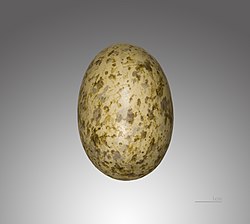A history of the birds of Europe, not observed in the British Isles (1875) (14749121191)
Identifier: historyofbirdsof41875bree (find matches)
Title: A history of the birds of Europe, not observed in the British Isles
Year: 1875 (1870s)
Authors: Bree, Charles Robert, 1811-1886
Subjects: Birds Birds
Publisher: London, G. Bell & Sons
Contributing Library: Harvard University, Museum of Comparative Zoology, Ernst Mayr Library
Digitizing Sponsor: Harvard University, Museum of Comparative Zoology, Ernst Mayr Library
View Book Page: Book Viewer
About This Book: Catalog Entry
View All Images: All Images From Book
Click here to view book online to see this illustration in context in a browseable online version of this book.
Text Appearing Before Image:
neck lighterand more mottled with brown, while the band across the crop betweenthe two black lines is much broader, and lighter in colour. The sideof the head is mottled like the back of the head and neck. Thewhite tips to the tail feathers are smaller, and the finely-extendedmiddle tail feathers rather shorter. In other respects like the male. The young of the year resemble the female, but are smaller. Thecrop shaded with greyish and russet, with spots and brown zigzags. My figures of the male and female of this bird are from specimenskindly sent me by Canon Tristram. The egg is from a specimenin my own collection: it was taken in S^^ain, and was sent to meby Moeschler. It has also been figured by Brisson, Ornithologia, vol. i., pi. 19,male and female; Buffon, pi. enl. 505 male, and 506 female; Roux,Ornith. Prov., pi. 247, adult male, pi. 248, fig. i. female adult, fig. ii.head of female of the year; pi. 249, fig. i. young just after leavingnest, and ii. male of year; Gould, pi. 258.
Text Appearing After Image:
SAND GROUSE. 135 GALLING. Fajnihj TETRAONID^. fBonaparte.) Genus Pterocles. f Temminck.J SAND GROUSE. Pterocles arenarius. Pterocles arejiaritis, Temminck. Gray; H.^L., 9457. Tetrao arenarius, Pallas. Perdix aiagonica, Latham. JEnas arenarius, Vieillot. Ganga unihande. Of the French. Ringel-flughuh7i, Of the Germans. Ganga, Savi. Specific Characters.—Only one band across the thorax; abdomen black.Tail wedge-shaped, and without any elongation of the middle feathers.Length of male thirteen inches; carpus to tip nine inches; beak eightlines; tarsus one inch and a quarter. The Sand Grouse inhabits the south of Europe, more especiallySpain. It occurs also in Sicily, and occasionally in Italy andGermany; more rarely still in New Russia and the Caucasus. It isfound only accidentally and as a straggler in Greece. Like the pre-ceding species it is a bird of the desert, and is at home in the sandyplains of Northern Africa and Eastern Asia. In the Eastern AtlasMr. Salvin tells us it occurs in
Note About Images
Relevantní obrázky
Relevantní články
Stepokur písečnýStepokur písečný je druh baculatého ptáka z řádu stepokurů, který se vyskytuje v Palearktické oblasti od Pyrenejského poloostrova přes severní Afriku a střední Asii až na severovýchod Indie. Typickým rozpoznávacím znakem druhu je černé břicho a bílý spodek ocasu. .. pokračovat ve čtení





